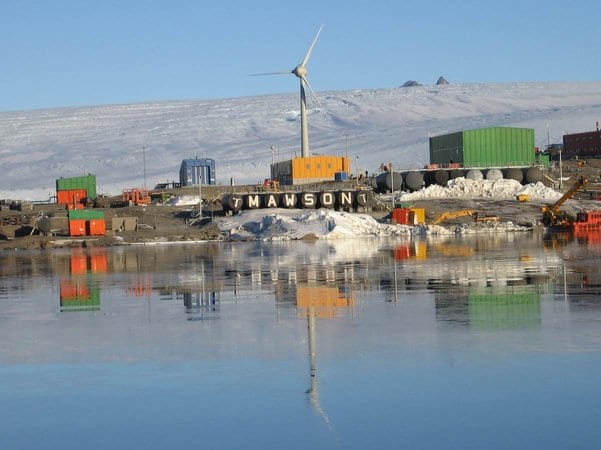Mawson Station, located on an isolated outcrop of rock at the edge of the Antarctic plateau, is the oldest surviving, continuously operated research station south of the Antarctic Circle. It’s also the most remote of the three main Antarctic stations operated by the Australian Antarctic Division (AAD). Ongoing scientific research at the station includes middle and upper atmosphere physics, cosmic ray physics, geomagnetism, seismology, biology, meteorology, climate change studies, medicine, and automated upper atmospheric sciences.
Two unique features make this station an ideal place to incorporate renewables for electricity generation. First, its remote location makes reliable delivery of diesel fuel difficult. Second, the wind resource in and around Mawson is outstanding. In 2002 and 2003, the AAD built two wind turbines at Mawson station, serving on average twenty researchers. Before installation began, the AAD completed an environmental impact assessment to ensure that the benefits of adding wind turbines outweighed potential negative ramifications including impacts on wildlife and the viewshed.
Mawson’s remote location and cold climate led to several challenges while preparing for and installing the two Enercon 300 kW wind turbines. The installation required a 100-ton crane, which called for the provision of a larger than typical icebreaking ship. Once the turbine components reached Antarctica, bridges at the station had to be strengthened to bear the weight of the vehicles transporting the turbines. Mawson station’s current electricity system includes 550 kW of diesel generator capacity, along with the 600 kW of total installed wind capacity. These resources are used to meet a load that peaks at 450 kW. Over the course of one year, approximately half of the electricity used at Mawson station comes from the wind turbines. The AAD website provides additional information about how this hybrid wind-diesel system is operated.
Overcoming challenges
Interestingly, Mawson station’s electrical loads go beyond thermal comfort, lighting, and plug-loads. The station also includes some luxuries for residents, such as a spa and a sauna, which require relatively large amounts of electricity compared to other day-to-day uses. In order to maximize fuel savings, the AAD worked to educate people about using these amenities only when wind energy is readily available, rather than at times of low wind when the diesel generators provide the majority of the electricity.
The wind turbines created an additional impact on Mawson’s heating supply that’s of note for other remote microgrids with large heating requirements. Before adding wind to the system, two diesel generators powered the Mawson station and extra heat from these generators heated many of the station’s buildings. With the addition of wind, just one diesel generator runs for most of the year. This slashes the diesel requirement, but it also removes the extra heat source from the now rarely used second generator. In response, the AAD added an electric boiler to the system in tandem with the wind turbines. With any extra power available from the wind turbines, the electric boiler pre-heats water to heat buildings. The boiler is also connected to Mawson’s system with a smart inverter, which provides voltage and frequency support to the microgrid. The result is similar to having additional spinning reserves, since the boiler can ramp its output up or down quickly when there is a shift in available wind.
In 2014 alone, the wind turbines generated enough electricity to reduce Mawson’s diesel consumption by 288,000 liters, directly saving the AAD $263,000 in fuel costs. The AAD also gained greater flexibility in scheduling resupply ships; instead of requiring a shipment of diesel fuel at least once per year to meet the station’s needs, the AAD can now send a refueling shipment every other year. The success seen at Mawson Station is already spreading, and other nations with operations in Antarctica have incorporated renewable resources for electricity generation. Furthermore, the now 10-year old wind turbines are still operating at high levels of efficiency—even in the tough winter climate.
For more on the electricity system at Mawson Station, and nine other renewable microgrids from around the world, download Renewable Microgrids: Profiles from Islands and Remote Communities Across the Globe.
Source: RMI. Reproduced with permission.












